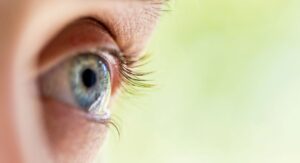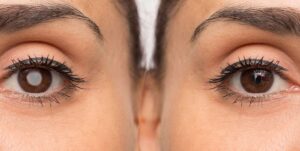Bilateral cataracts are a condition that affects both eyes simultaneously. This can cause blurred vision, glare, and other vision problems. If you are experiencing any of these symptoms, it is important to see your doctor right away. In this blog post, we will discuss the causes and symptoms of bilateral cataracts, as well as treatment options.
Contents
What Are Bilateral Cataracts?
 Bilateral cataracts are when a person has simultaneous clouding of the lenses in both eyes. Cataracts occur when the proteins that make up the lens of the eye become clumped together and cause it to become opaque and blurry. As a result, vision becomes increasingly blurred over time as the cataract progresses.
Bilateral cataracts are when a person has simultaneous clouding of the lenses in both eyes. Cataracts occur when the proteins that make up the lens of the eye become clumped together and cause it to become opaque and blurry. As a result, vision becomes increasingly blurred over time as the cataract progresses.
The development of cataracts in both eyes can create a significant problem for the person’s everyday life. But, the development is not always at the same rate and can occur over many years, or even decades. You should be aware of the possible warning signs of bilateral cataracts, and if you experience any changes in your eyesight, it is important to seek medical help.
What Are The Different Types?
When you hear the term “bilateral cataracts,” it generally refers to cataracts that affect both eyes. There are three types of bilateral cataracts: congenital, traumatic, and age-related. Let’s discuss them in turn.
Congenital cataracts are the most common type of bilateral cataract and occur when a baby is born with a clouded lens due to genetic factors or other prenatal causes. Traumatic cataracts are caused by an injury to the eye, such as blunt force trauma, laceration, radiation exposure, or chemical burns. Age-related cataracts, also known as senile cataracts, are caused by age-related changes to the lens of the eye and develop slowly over time.
Each type of cataract can be treated differently, depending on its cause and severity. Generally, surgery is recommended to remove cloudy lenses in order to restore vision.
What Are The Symptoms Of Bilateral Cataracts?
This might be the first question you have if you think that you or a loved one might be suffering from bilateral cataracts. The most common symptom of this condition is blurred vision. This may worsen as cataracts increase in size and density. Other symptoms include:
- Double vision: It happens when light rays entering the eye are focused on two different points instead of one.
- Glare: When looking at bright lights, they may appear to be ‘haloed’ by a ring of light.
- Poor night vision: Vision can become blurry and distorted when transitioning between light and dark environments.
- Frequent changes in the eye: This includes changes in the eye’s shape, color, or size.
- Colors appear faded: The lens of the eye is responsible for focusing color and if it becomes cloudy, colors can start to look washed out.
The symptoms might vary from person to person, and it’s important to have a comprehensive eye exam if you’re having any issues with your vision. Bilateral cataracts can be treated successfully and the sooner you detect it, the better your outcome will be.
What Are Some Causes And Risk Factors?
 When it comes to the causes and risk factors of bilateral cataracts, there are a few different things that can lead to this condition.
When it comes to the causes and risk factors of bilateral cataracts, there are a few different things that can lead to this condition.
Common causes include:
- Genetic mutations: It is one of the most common causes of bilateral cataracts. Certain genetic mutations can cause proteins to develop abnormally in the lens, leading to a clouding of the vision.
- Age: As an individual ages, the proteins in their eyes begin to break down and clump together, causing a decrease in clarity and vision. This is known as age-related cataracts, and it is the most common form of cataracts that affects people over the age of 50.
- Injury or trauma: Accidents or impact injuries can cause the lens of the eye to be damaged, which can lead to a clouding in vision.
- Radiation exposure: Exposure to high levels of radiation can also damage proteins in the lens, leading to clouded vision.
Other risk factors for developing bilateral cataracts include:
- A family history of cataracts
- Previous eye surgery
- Illnesses such as diabetes and hypertension
- Smoking
- Drinking alcohol
- Prolonged exposure to UV rays from the sun
These causes are much different than the causes of unilateral cataracts, which is why it’s important to understand the differences between the two. With the right information and care, it’s possible to treat and prevent the progression of bilateral cataracts.
How Is It Diagnosed?
A diagnosis is an important step in treating and managing bilateral cataracts. An eye doctor typically diagnoses it by performing a comprehensive eye exam that includes:
- A visual acuity test: This is to measure how well a person can see at various distances.
- A refraction test: This evaluates the amount of near- or farsightedness present.
- Slit lamp exam: This helps the doctor identify any abnormalities in the cornea, lens, and other parts of the eye.
- Fundoscopic exam: This looks inside the eye to detect any visible signs of cataracts.
- Pupil dilation: It is essential for the doctor to assess the condition of the retina and optic nerve.
If an eye doctor suspects a person may have bilateral cataracts, they will typically refer them to an ophthalmologist for further testing. This can include imaging tests such as ultrasound or CT scans and biopsies.
These tests help the ophthalmologist determine the type and severity of cataracts, as well as develop a treatment plan. An accurate diagnosis can be a critical factor in determining the success of any treatment or surgery.
How To Treat Bilateral Cataracts?
Bilateral cataracts affect both eyes and can cause vision impairment if left untreated. The most effective treatment for bilateral cataracts is surgery. During the procedure, an ophthalmologist will remove the cloudy lens and replace it with an artificial lens, restoring your vision.
The surgery for this cataract is also an outpatient procedure, meaning you can go home the same day. Your doctor will take several measurements to make sure your new lens is the correct size and shape for your eye. Afterward, they may recommend that you wear an eye patch and sunglasses during the healing process.
Your ophthalmologist might also suggest using medicated drops or ointments for the first few weeks after surgery to help reduce inflammation and swelling. Additionally, you may need to use protective eyewear when outdoors or in brightly lit areas for several months following your surgery.
Follow-up appointments with your doctor are essential in the healing process of bilateral cataracts. Your doctor will monitor your vision as it recovers and makes sure that the new lens is functioning properly. If your vision does not improve, additional treatments or surgeries may be recommended.
With proper care and monitoring, bilateral cataracts can be treated effectively with minimal risks associated with the surgery. A successful outcome of this procedure will restore clear vision and lead to improved quality of life.
Can It Be Prevented?
 Well, many cases of bilateral cataracts cannot be prevented. It is caused by aging, the use of certain medications, or injury to the eye. However, there are steps you can take to reduce your risk factors for developing bilateral cataracts. These tips might include:
Well, many cases of bilateral cataracts cannot be prevented. It is caused by aging, the use of certain medications, or injury to the eye. However, there are steps you can take to reduce your risk factors for developing bilateral cataracts. These tips might include:
- Wearing UV-protective sunglasses when outdoors, even on cloudy days.
- Eating a healthy diet and exercising regularly to maintain good overall health.
- Not smoking cigarettes or using other tobacco products, as these can increase the risk of developing cataracts.
- Keeping your eyes lubricated with eye drops to reduce dryness.
- Seeing your doctor regularly for routine eye exams.
Overall, it is important to be aware of your risk for developing bilateral cataracts and to take steps where possible to reduce it. If you have any concerns about your eye health, talk to your doctor for more information. With proper prevention and timely treatment, the symptoms of bilateral cataracts can often be managed successfully.
Conclusion
In a conclusion, bilateral cataracts may be defined as simply a condition in which the lens of both eyes is clouded, resulting in a decrease or complete loss of vision. It is an age-related eye disease that typically increases with age and can lead to permanent blindness if left untreated.
Fortunately, modern cataract surgeries have become increasingly successful at restoring vision and reducing symptoms associated with the condition. Hence, do not hesitate or lose hope if you or a loved one is suffering from bilateral cataracts. Consult your doctor and take the necessary steps to safeguard your vision today!
For more information and guidance, do contact Mantra Care. At MantraCare we have a team of experienced eye surgeons, who will be happy to answer any questions on cataract surgery. Call us at +91-9711116605 for any inquiries.
